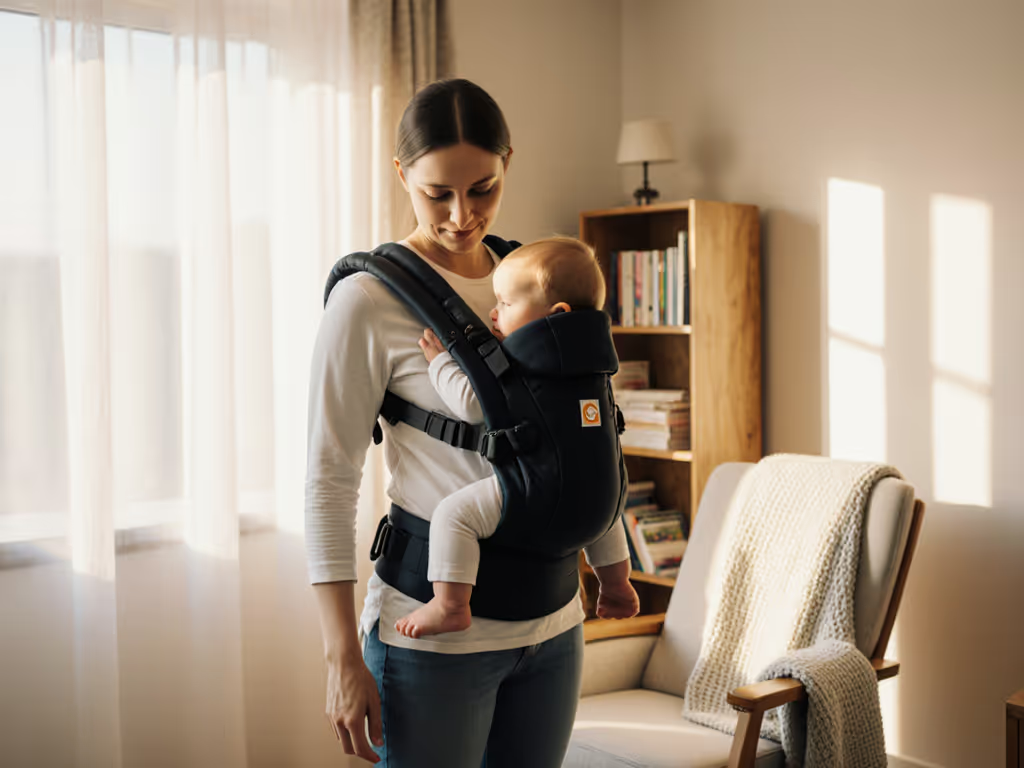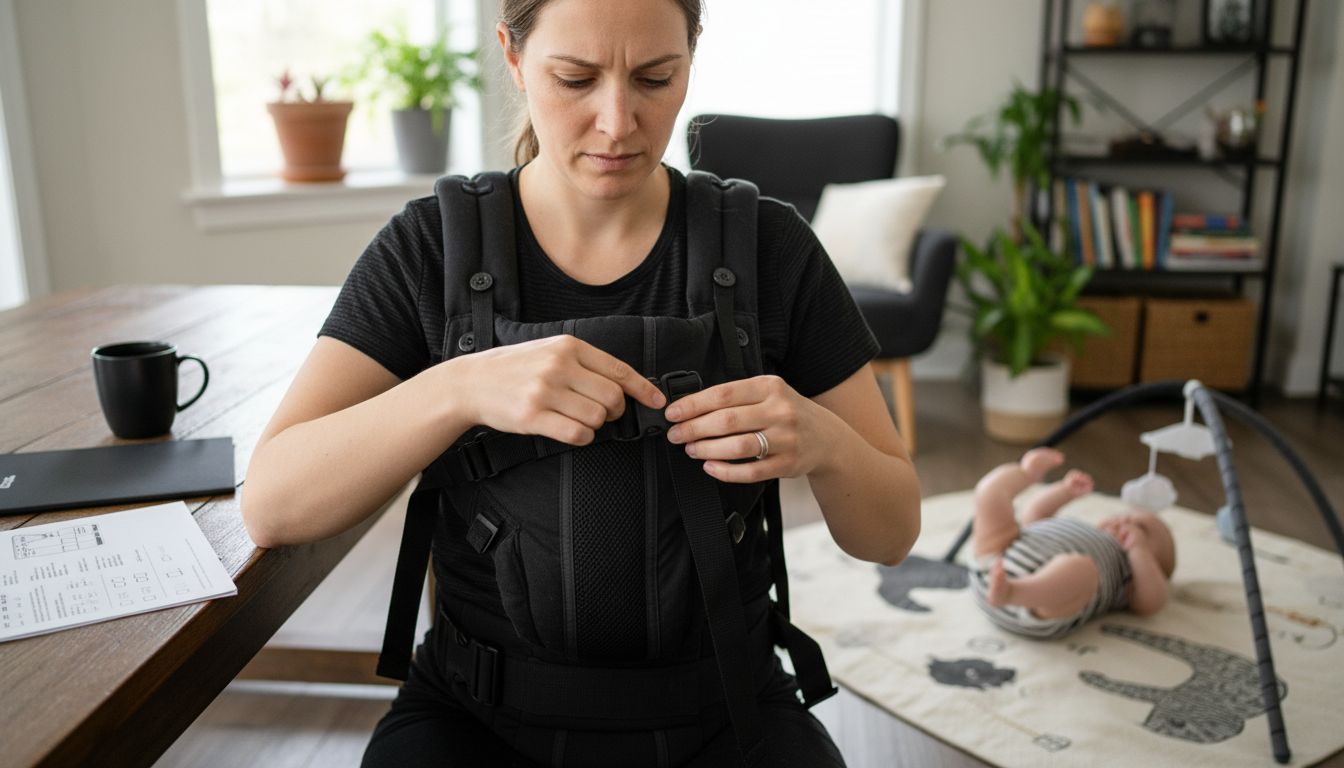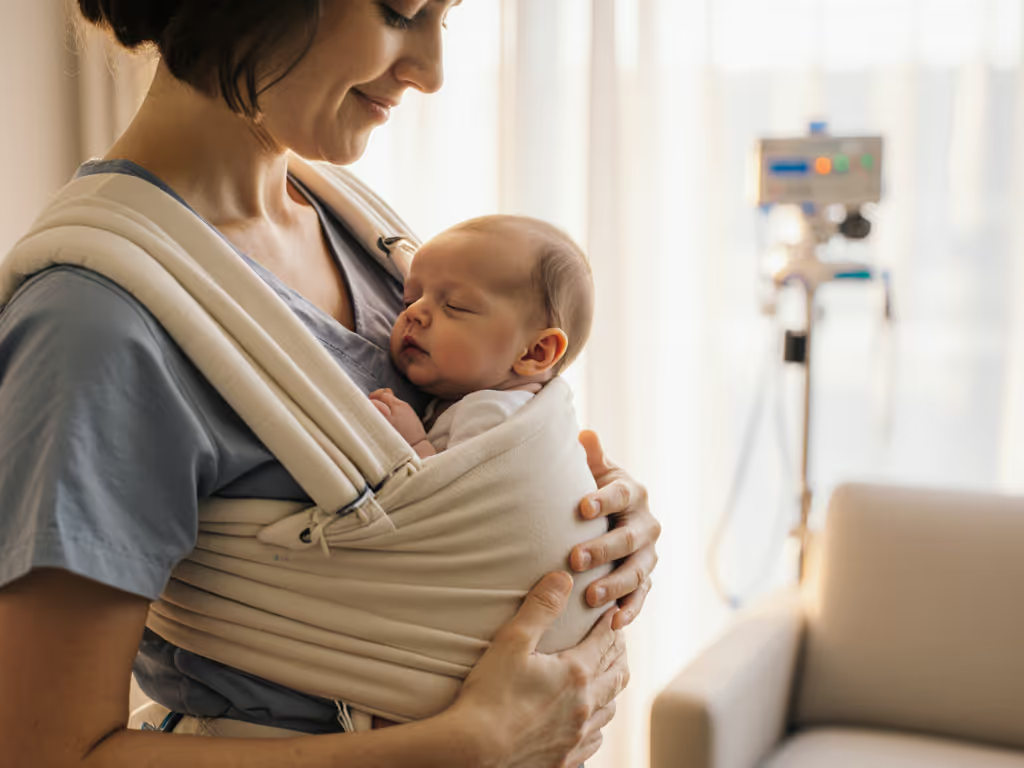
Baby Carrier Safety: Everything You Need to Know

Nearly 2,000 babies are rushed to emergency rooms each year due to carrier-related injuries, most of which could have been avoided with proper use. Babywearing brings comfort and connection, but safety must remain the top priority for every parent or caregiver. When you know the key principles and understand how to spot potential hazards, you can create a secure and nurturing space for your little one with confidence.
Key Takeaways
| Point | Details |
|---|---|
| T.I.C.K.S. Rule | Adhere to the T.I.C.K.S. rule for safe babywearing: Tight fit, In view, Close enough to kiss, Keep chin off chest, and Supported back. |
| Regular Inspections | Inspect the carrier regularly for signs of wear or damage to ensure your baby's safety. |
| Appropriate Positioning | Position the baby correctly to maintain proper airflow and spinal support, preventing potential respiratory issues. |
| Avoid Common Mistakes | Be mindful of typical safety mistakes such as overheating and incorrect positioning to create a secure babywearing experience. |
Defining Baby Carrier Safety Principles
Baby carrier safety isn't just about selecting a cute product - it's about understanding fundamental principles that protect your child's physical development and prevent potential accidents. Safety principles are critical guidelines that ensure your infant remains secure, comfortable, and protected during babywearing activities.
The T.I.C.K.S. rule provides an excellent framework for safe babywearing practices. This internationally recognized standard breaks down essential safety components:
- Tight: Carrier must fit snugly against the caregiver's body
- In view: Baby's face should always be visible
- Close enough to kiss: Baby's head should be close to the caregiver's chin
- Keep chin off chest: Ensure an open airway at all times
- Supported back: Maintain a natural spine position
Health Canada's research highlights critical safety concerns, revealing serious injuries often result from three primary factors: caregiver trips, product failures, and improper usage. Selecting a carrier with detailed instructions, ensuring proper fit for both caregiver and baby, and conducting regular damage assessments can significantly mitigate these risks. Proper positioning isn't just about comfort - it's about preventing potential respiratory issues and supporting your baby's delicate musculoskeletal development.

Ultimately, baby carrier safety demands continuous attention, education, and mindful practice. By understanding and implementing these core principles, you transform a simple carrier into a secure, nurturing environment for your child's early mobility experiences.
Major Types of Baby Carriers Compared
Understanding the landscape of baby carriers means recognizing that not all carriers are created equal. Each type serves different purposes, addresses unique parental needs, and provides varying levels of comfort and support for both caregiver and child. Your ideal carrier will depend on factors like your baby's age, your physical comfort, and your daily activities.
The primary categories of baby carriers include:
Here's a comparison of major baby carrier types and their key features:
| Carrier Type | Best For | Main Features | Notable Considerations |
|---|---|---|---|
| Wraps | Newborns | Soft fabric<br>Custom fit | Learning curve for tying |
| Soft-Structured Carriers | Infants & Toddlers | Buckles<br>Padded straps<br>Versatile | Bulkier<br>Sizing adjustments needed |
| Half-Buckle Carriers | All ages | Structured waist<br>Wrap shoulder straps | Combines structure and flexibility |
| Hip Carriers | Older babies<br>Quick trips | Ergonomic<br>Side carry support | Shorter sessions only |
| Meh Dai | Infants & Toddlers | Tie straps<br>Soft body | Traditional design<br>Flexible positions |
| Onbuhimo | Sitting infants & up | Waistless<br>Back carry | Less head/neck support |
- Wraps: Soft, stretchy fabric perfect for newborns, offering an incredibly snug and intimate carrying experience
- Soft-Structured Carriers: Versatile options with buckles and padded straps, supporting multiple carrying positions
Specialized Carrier Types expand beyond these basic categories:
- Half-Buckle Carriers: Combine structured waistbands with wrap-style shoulder straps
- Hip Carriers: Designed for ergonomic support during shorter carrying sessions
Traditional designs like meh dai carriers featuring soft bodies and tie straps offer another fascinating option.
These carriers bridge the gap between modern structured designs and traditional babywearing techniques, providing flexibility and cultural connection. The onbuhimo style, a waistless carrier ideal for back carries, represents another innovative approach to infant transportation.
Choosing the right carrier isn't just about convenience - it's about creating a safe, comfortable environment that supports your baby's physical development while meeting your practical needs. Consider your lifestyle, physical comfort, and your infant's age when selecting a carrier that will become an essential part of your parenting journey.
Safe Babywearing: Key Features and Standards
Babywearing safety goes far beyond simply picking a carrier that looks comfortable. It requires a comprehensive understanding of critical design elements that protect your infant's developing body and ensure secure transportation. The most advanced carriers are engineered with precise anatomical considerations, focusing on supporting your baby's delicate physical structure during critical developmental stages.
Key safety features every parent should prioritize include:
- Hip Support: Ensuring proper leg positioning to prevent hip dysplasia
- Spine Alignment: Maintaining a natural "M" shaped seated position
- Breathable Materials: Allowing air circulation to prevent overheating
- Weight Distribution: Evenly spreading your baby's weight across your body
The internationally recognized T.I.C.K.S. rule provides a simple yet comprehensive safety framework. This standard emphasizes five critical components:
- Tight: Carrier must fit snugly against the caregiver
- In view: Baby's face always visible
- Close enough to kiss: Baby's head near caregiver's chin
- Keep chin off chest: Maintain an open airway
- Supported back: Natural spine positioning
Recognized organizations like the International Hip Dysplasia Institute have established rigorous standards for carrier design. Some manufacturers, such as BabyBjörn, have received specific recognition for creating hip-healthy carrier models. These certifications provide parents with confidence that their chosen carrier supports optimal physical development while ensuring maximum safety during those precious early months of mobility and bonding.
Key Roles and Responsibilities for Caregivers
Babywearing is a profound responsibility that demands active engagement, continuous learning, and unwavering attention to your child's safety and comfort. Caregiver vigilance transforms a simple carrier into a secure environment that supports your baby's physical and emotional development.
Critical responsibilities for safe babywearing include:
- Carrier Selection: Choose carriers that match your baby's age, weight, and developmental stage
- Fit Verification: Ensure the carrier provides proper support for your baby's spine and hips
- Continuous Monitoring: Regularly check your baby's position, breathing, and comfort
- Physical Awareness: Be mindful of your movements and potential environmental hazards
Health Canada emphasizes several key inspection and usage guidelines:
- Read and follow manufacturer instructions precisely
- Inspect carrier for any signs of wear or damage before each use
- Practice putting on the carrier in front of a mirror or with assistance
- Avoid complex movements or activities that could compromise safety
The T.I.C.K.S. rule serves as a fundamental framework for caregiver responsibilities. This means maintaining a tight fit, keeping the baby in view, staying close enough to kiss, ensuring the baby's chin remains off their chest, and supporting their back. These aren't just recommendations - they're critical steps in preventing potential respiratory issues and ensuring your baby's physical safety during babywearing.
Avoiding Common Baby Carrier Safety Mistakes
Even well-intentioned parents can unknowingly compromise their baby's safety through seemingly minor carrier mistakes. Understanding and recognizing these potential pitfalls is crucial for creating a secure babywearing experience that protects both caregiver and child.
The most critical safety mistakes to avoid include:
- Incorrect Positioning: Allowing baby's chin to rest on their chest, which can restrict breathing
- Worn-Out Carriers: Using carriers with stretched fabric, broken buckles, or visible wear
- Overheating: Dressing baby too warmly inside the carrier
- Compromised Visibility: Positioning baby where you cannot constantly monitor them
Health Canada's research highlights several high-risk scenarios that demand immediate attention:
- Never use a carrier with visible damage or structural weakness
- Avoid complex physical activities while babywearing
- Constantly check your baby's breathing and color
- Adjust carrier immediately if baby appears uncomfortable or distressed
The T.I.C.K.S. rule serves as your ultimate safeguard against potential mistakes. By maintaining a tight fit, keeping your baby in view, staying close enough to kiss, preventing chin compression, and supporting their back, you create a protective bubble that minimizes risks. Remember: babywearing is an art that requires continuous learning, careful attention, and a commitment to your child's safety above all else.
Ensure Your Baby Carrier Experience is Safe and Comfortable Today
Navigating the world of baby carrier safety can feel overwhelming with the many challenges highlighted in the article such as proper positioning, fit, and avoiding common mistakes like restricting your baby's breathing or using worn-out carriers. You want confident guidance that helps you protect your child’s delicate spine and hips while keeping the wearer comfortable and secure. The well-known T.I.C.K.S. rule and understanding different carrier types form a strong foundation but putting that into practice takes trusted knowledge and dependable resources.
At Caregiver Carry, we share your commitment to safe babywearing and make it easier to apply those essential safety principles. Explore our detailed guides that break down the T.I.C.K.S. rule, discover comprehensive reviews that help you select carriers matching your baby’s age and your lifestyle, and use our step-by-step instructions to perfect positioning and support. Don’t wait to enhance your babywearing confidence and protect your child’s development. Visit Caregiver Carry right now to access expert advice and find the perfect carrier tailored to your needs.
Frequently Asked Questions
What are the key safety principles for using a baby carrier?
The key safety principles for using a baby carrier can be summarized by the T.I.C.K.S. rule: Tight (the carrier must fit snugly), In view (the baby's face should always be visible), Close enough to kiss (the baby’s head should be near the caregiver's chin), Keep chin off chest (ensure an open airway), and Supported back (maintaining a natural spine position).
How can I ensure my baby is positioned correctly in a carrier?
To ensure correct positioning, make sure your baby maintains an "M" shaped seated position with their knees higher than their hips. Check that their back is supported, and their chin is off their chest to avoid airway compression. Regularly adjust the carrier as needed for comfort and support.
What are the common mistakes to avoid when using a baby carrier?
Common mistakes to avoid include incorrect positioning that allows the baby's chin to rest on their chest, using worn-out carriers, overdressing the baby leading to overheating, and compromising visibility where you can't monitor your baby's breathing and comfort.
How often should I inspect my baby carrier for safety?
It's crucial to inspect your baby carrier for signs of wear or damage before each use. Check for stretched fabric, broken buckles, or structural weaknesses, and always follow manufacturer instructions for proper use to ensure safety.



